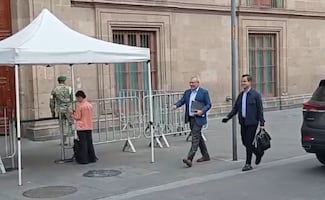Más Información

Senador del PT propone crear televisión, radio y periódico de la 4T; debemos hacer frente a medios de derecha, dice

César Duarte comparece ante jueza en penal del Altiplano; buscan vincularlo por presunto lavado de dinero

¿Qué es el Tratado de Aguas de 1944 entre México y EU por el que Trump amaga con imponer aranceles?; te explicamos

Gobernador de Michoacán se reúne con Sheinbaum en Palacio Nacional; acude también gabinete de Seguridad

Posponen en el Senado discusión y votación de reforma para crear la figura de “jueces sin rostro”; se discutirá en febrero

VIDEO Hallan a pareja sin vida en colonia Lindavista; una de las víctimas era abogado que litigó temas de despojos en Ecatepec
She has been detecting explosives in Mexico City for seven and a half years. Blue , a labrador dog from the Canine Unit of Mexico City’s Citizen Security Ministry (SSC) stops to rectify with her smell the content inside a wooden box, amidst an exhibition.
She set her sight on the box until a police officer comes by and takes it away with both hands. With expressive eyes and with a little bit disconcerted, Blue is taken away from the place where minutes ago a ball had bounced making her run on the grass.
Although everything was part of an exhibition of he r police skills to detect bombs , the trainer had to follow the protocols that would be followed in a real dangerous situation.
Have you heard of
?
With eight years and a half of age, Blue is the eldest member of the 24 dogs that make up the Canine Unit of the Task Force Group . According to the institutional protocols, she must retire when she is nine years old, but her results in the daily training and her immediate reaction have made the officers keep considering her for explosive detection which “are frequent” in Mexico City.
Blue repeats the operation. She wears an official black vest , the color of her fur; the trainer kneels and taps her twice in the chest to call her attention.
- Ok, Blue… Search! - The dog leaves quickly until she arrives at the sixth wooden box, inside which is a device that looks like an explosive ; she was right once again and is rewarded with the ball.
Out of the 24 dogs, Blue is the heaviest; according to the veterinarians , she is overweight. However, she is reluctant to her diet of premium croquettes being reduced.

Daniel Álvarez Amaro
, second official in charge of dog training, told EL UNIVERSAL a particular anecdote of the dog: “When we took the portions from her diets, she stopped doing her exercises, that is why we decided to leave it like that, that is how it works for all of us.”
Despite being overweight, which is barely noticeable, she is fast and strong and shines with energy. After her exhibition, she focused on the ball that bounces in all the field.
Did you know
, is now retired?
Training
Second official Daniel Álvarez told EL UNIVERSAL that the canine unit has four areas of expertise: narcotics detection, explosive detection, location of people in collapsed buildings, and location of corpses or human remains.
The dogs’ preventive tracking varies according to their statistics, but regarding massive events, be it a religious, political, or cultural meeting, they perform from three to four of them per day.
As of the search of people, corpses, and drugs, the average is one service per day , specifically in drug detection.
Álvarez Amaro explains that the first thing they do in the canine unit is to do a selection of the dogs since they are puppies, most of them are donated , to determine their kind of temperament, disposition, and energy.
In addition, the dogs must have “very basic instincts but strong in the prey sense, of possession, of the pack, and hierarchy. They must be very balanced dogs but with a lot of disposition to work.”
“Then, we have a line of training to make them stronger and to improve the characteristics we need, like something as delicate as explosive detection. We see the kind of dog we are working with and that defines which specialty we assign them.”
Have you heard of
?
The training, he adds, can be simple, like playing with a ball in a room with 30 people. This is done to observe the skills of the animals to develop in an environment with many people.
If a dog covers large spaces of land, the trainers know that it must be trained for the search of people; the trainer must pay attention to the language of each dog to define which will be its area of expertise.
“It’s as simple as playing with a ball or as complex as getting a dog on a helicopter and for it to stand the journey or the noises of the turbulence. Initially, the training must be eight months long for the dog to be able to operate in the street .
“However, when the dogs go out, new details emerge and we must keep refining them during the whole dog’s career, ” he comments.
Such a career consists of nine years of life , asserts Álvarez Amaro. When the dogs reach that age, they must be retired from police operations. However, if they do not present joint problems or any other health issue, they can keep working for another year and a half.
During training, dogs must not be forced to anything, for “everything must be nice for them, if I did it nice for me and my dog is not happy, it’s possible that it won’t do it again.”
The canine unit has three veterinarians to take care of the 24 dogs; they design their diet of premium croquettes . Every day, the dogs get individual baths and brushing, and have their own cage; they never live in a commune.
Have you heard of
?
A second chance
Since they have a complex training and are socialized with the members of the institution, the police dogs of the canine unit cannot live in a home as pets, for they are used to another kind of treatment, explains Daniel Álvarez.
That is why the SSC has a retirement program for police dogs that consists of maintenance “as if they were operating,” but with their own need, since “only the dog’s joints age, but its mind is that of a puppy.”
“Our dogs do not leave, they are not donated, they don’t go to another home, they stay with us until they die naturally ,” highlights the official, who also says that until now, five dogs have already retired.
Álvarez Amaro sends the last message, “Our working dogs came in as donations. The idea is to give a second chance not to the dog but to all of us. The number of dogs in the streets did not emerge by itself, we all cooperated with it and when a dog doesn’t have a place where to be, a home, or is an exiled, it's a problem we all created. In this institution when we adopt, we are giving a second chance.”
Don't you think rescue dogs are
?
mp
Noticias según tus intereses
[Publicidad]
[Publicidad]








